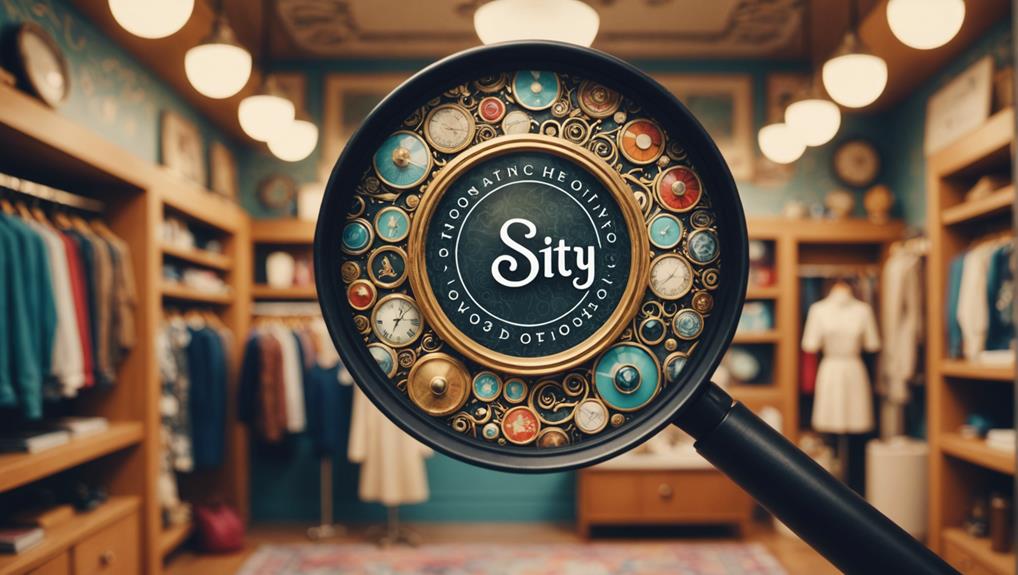To take stunning photos for your Etsy listings, start by mastering natural light, positioning your products near windows for soft, even images. Invest in a tripod to guarantee sharpness and experiment with camera settings to control focus and blur. Use a plain white background to focus attention on your products and consider incorporating props to add visual interest. Don't forget to capture detailed close-ups to showcase unique features. By following these tips, you'll be well on your way to creating visually appealing photos that drive sales and build trust with customers – and there's even more to explore to take your photography skills to the next level.
Key Takeaways
- Position products near a window for soft, even lighting and minimize harsh shadows.
- Use a tripod to capture sharp, detailed close-up shots and showcase products in the best light.
- Opt for a plain white background or solid colors to avoid distractions and focus on the product.
- Experiment with camera settings, such as aperture and ISO, to master exposure and focus.
- Capture products in lifestyle settings, using props and natural light, to help customers envision product integration.
Mastering Natural Light
By positioning your products near a window, you can harness the power of natural light to create soft, even, and visually appealing images for your Etsy listings. Natural light provides the perfect conditions for capturing high-quality photos, and it's free!
Shooting near a window allows you to take advantage of the soft, diffused light that reduces harsh shadows and adds dimension to your images. Experiment with different angles to make the most of natural light in your Etsy product photography. Don't be afraid to get creative with shadows – they can add depth and visual interest to your photos.
If possible, consider shooting outdoors to reduce shadows and add even more dimension to your images. Remember, the key to mastering natural light is to experiment and find the perfect balance of lighting for your products. By doing so, you'll be able to showcase your items in the best possible way, increasing the chances of attracting potential buyers to your Etsy listings.
Tripod Essentials for Sharpness

Capturing sharp, high-quality images for your Etsy listings requires an essential piece of equipment: a tripod. A tripod guarantees your camera remains steady and focused, allowing you to snap precise photos that showcase your products in the best possible light.
With a tripod, you'll enjoy several benefits that enhance your product photography. Here are three key advantages:
- Minimized camera shake: A tripod guarantees steady shots, minimizing camera shake for sharper images.
- Detailed close-up shots: Using a tripod is essential for capturing detailed close-up shots with precision.
- Enhanced overall sharpness: Tripods improve overall photo sharpness and clarity, making your products stand out.
Backdrop Basics for Distraction-Free Photos

Clarity is key when it comes to showcasing your products, and a well-chosen backdrop can make all the difference in keeping the focus squarely on what you're selling.
When it comes to Etsy photos, a plain white background is often the way to go, as it allows your product to take center stage without distractions. If you want to add some color, stick to solid colors that create a cohesive look. Avoid using busy or cluttered backgrounds that could take attention away from your product.
To add some visual interest, incorporate props strategically to enhance the presentation of your products. You can also experiment with different backdrop materials to find the best fit for your products. Remember, the goal is to showcase your product in the best possible light, not to create a busy or distracting scene.
Capturing Details With Close-Ups

When you zoom in on the intricate details of your products, you're giving potential buyers a tangible sense of what they can expect from your craftsmanship. Close-up photos are essential for showcasing the intricacies and textures of your products, and using a macro lens or setting can help you capture sharp and detailed shots of small objects.
Here are three tips to keep in mind when capturing details with close-ups:
- Focus on specific features:
Highlight the uniqueness of your items by focusing on specific features like stitching, textures, or finishes.
- Experiment with angles and lighting:
Try different angles and lighting setups to capture the best close-up shots for your Etsy listings.
- Showcase product quality:
Use close-ups to demonstrate the quality of your products and give customers a better understanding of what they're buying.
Experimenting With Camera Settings

As you experiment with camera settings, you'll discover how to harness the look and feel of your Etsy listing photos.
You'll learn to adjust aperture to manipulate depth of field, ISO to fine-tune lighting, and shutter speed to create motion blur or freeze fast-moving subjects.
Aperture and Depth Control
You can manipulate the aperture to creatively control the focus and blur in your Etsy product photos, allowing you to draw attention to specific details or showcase the entire product. By adjusting the aperture settings, you can create stunning product photography that showcases your items in the best possible light.
Here are three key things to keep in mind when experimenting with aperture:
- Lower f-stop settings (wider aperture) create a shallow depth of field, ideal for isolating subjects and drawing attention to specific details.
- Higher f-stop values (narrower aperture) increase the depth of field, keeping more of the image in focus.
- Experiment with different aperture settings to control focus and blur in your Etsy product photos, enhancing the visual appeal and professionalism of your listing photos.
ISO and Lighting Settings
Mastering ISO and lighting settings is crucial to capturing well-exposed and high-quality product photos for your Etsy listings. It directly impacts the overall aesthetic and professionalism of your online store. When experimenting with camera settings, you'll want to understand how to balance ISO with other lighting settings to achieve excellent results.
You can control the sensitivity of your camera's sensor to light by adjusting the ISO settings. In low-light situations, higher ISO settings can help, but be cautious of introducing noise or grain in your photos. On the other hand, lower ISO settings produce cleaner images but require more light for proper exposure.
Focusing on the Subject
By experimenting with camera settings, such as aperture, shutter speed, and ISO, you're able to take creative control of focus and exposure, ensuring your Etsy listing photos stand out. This allows you to focus on the subject, drawing the viewer's attention to the product.
To achieve this, try the following:
- Adjust aperture: Create a shallow depth of field, blurring the background and highlighting the subject.
- Manipulate shutter speed: Freeze motion with a fast shutter speed or create creative effects like light trails with a slow shutter speed.
- Control ISO: Balance brightness and image quality by adjusting the camera's sensitivity to light.
Understanding how each setting affects the final image helps in capturing stunning photos of your Etsy listings.
Editing for Professional Results

To enhance your Etsy listings, harness the power of photo editing tools like Adobe Photoshop or Canva to transform your images into stunning visuals that showcase your products in the best possible light.
Through photo editing, you can refine your images to make them more appealing to potential buyers. Adjusting the white balance, exposure, and contrast can greatly enhance the overall quality of your images.
Additionally, use cropping and framing techniques to highlight the key elements in your photos, drawing attention to the product's best features.
Consistency in your editing style across your listings is essential, as it creates a cohesive and professional look. Don't be afraid to experiment with different editing techniques to find the best enhancements for your product photos.
Image Rotation and Thumbnail Tips

When uploading your product photos to Etsy, make sure they're accurately oriented to showcase your items from their best angle. Etsy auto-rotates photos based on camera information to guarantee correct orientation. However, if your camera doesn't provide this information, you can use photo editing tools to rotate sideways images for proper alignment.
To make sure your thumbnails look their best, follow these tips:
- Leave a border: Guarantee thumbnail images have enough border for square cropping on Etsy.
- Capture extra space: Capture images with extra space around items to allow for cropping adjustments.
- Opt for a 4:3 aspect ratio: Avoid square crops and aim for a 4:3 aspect ratio for the best thumbnail display.
Recommended Photo Sizes and Ratios

You'll want to upload photos that align with Etsy's recommended size and ratio guidelines to make sure your products are showcased in the best possible light. When taking photos for your Etsy listings, aim to upload high-resolution photos that are at least 2000 pixels on the shortest side. This will guarantee your product looks crisp and clear, even when zoomed in. Additionally, ensuring good lighting and clean backgrounds will help draw attention to the details of your product, allowing potential buyers to clearly see what you’re offering. Keep in mind that high-quality photos can significantly increase the chances of making a sale. For tips on managing downloads post-purchase, you can refer to guides on how to download Etsy files, ensuring a smooth experience for both sellers and buyers alike.
Additionally, make sure to shoot in a 4:3 aspect ratio in landscape orientation, as this is the ideal ratio for Etsy listing photos. This will prevent your images from appearing distorted or cropped. By following these guidelines, you'll be able to showcase your product in the most effective way, attracting more customers and enhancing visibility.
Consistency is key, so try to maintain the same aspect ratio across all your listings to create a professional and cohesive look for your shop. By taking the time to get your photo sizes and ratios right, you'll be able to take stunning photos that do your products justice.
Watermarking and Copyright Protection

By focusing on high-quality, unobstructed visuals, you can create a more engaging shopping experience for potential buyers, rather than relying on watermarks to protect your intellectual property. Etsy discourages watermarking your listing photos as it can distract from the product and diminish visual appeal. Instead, prioritize high-quality images that showcase your products in the best possible light. This will attract customers and lead to sales.
Here are some tips to protect your intellectual property without watermarks:
- Add a copyright notice in your item description to assert your rights.
- Use Etsy's built-in features for intellectual property rights to safeguard your work.
- Focus on creating high-resolution, clear photos that showcase your products from different angles, making it difficult for others to replicate.
Showcasing Products in Lifestyle Settings

When showcasing your products in lifestyle settings, you're not just taking a photo – you're creating a narrative that helps customers imagine themselves using your product.
By placing your item in a real-life scenario, you're giving buyers a better understanding of how it can fit into their daily lives.
Now, let's explore the key elements that make lifestyle photos truly effective, from using real-life settings to incorporating props and natural light environments.
Real-Life Settings Matter
Incorporating lifestyle settings into your product photography helps potential buyers envision how your item can seamlessly integrate into their daily lives. By showcasing your products in real-life settings, you're allowing customers to imagine themselves using your item, making it more relatable and desirable. This approach creates a connection with customers, as they can envision how your product fits into their lifestyle.
Here are three ways to effectively use real-life settings in your product photography:
- Use props and backgrounds that complement your products to enhance the overall appeal and create a cohesive look.
- Show products in use, demonstrating how they can be used in everyday life, making them more tangible and appealing.
- Create a storyline with your lifestyle photos, conveying the mood, style, and functionality of your products, and giving customers a glimpse into the product's usage.
Natural Light Environments
You can instantly elevate your Etsy listing photos by capturing your products in natural light environments that mimic real-life settings. This approach helps customers envision how your items can be used in their daily lives. To achieve ideal natural light exposure, position your products near windows or take them outdoors for a more dynamic look.
Varying lighting conditions can add depth and interest to your photos. Experiment with different angles and compositions to capture the essence of your products in natural light environments.
When showcasing products in lifestyle settings, utilize natural light to create soft, flattering lighting that enhances their appeal. Outdoor settings can provide varied lighting conditions and backgrounds, allowing you to capture unique perspectives. By experimenting with different angles, you can highlight the features and details of your products.
Styling With Props
To take your Etsy listing photos to the next level, incorporate thoughtfully chosen props that create a lifestyle setting, allowing customers to imagine themselves using your products in real-life scenarios. This styling technique enhances the appeal of your products by adding context and helping customers visualize how they can use them.
When selecting props, keep the following tips in mind:
- Choose relevant props that complement your products without overshadowing them.
- Use props strategically to convey the story or use of your products.
- Select props that enhance the features or benefits of your products.
Frequently Asked Questions
How Do I Optimize Photos for Etsy?
To optimize photos for Etsy, you'll want to upload high-resolution images with a 4:3 aspect ratio, at least 2000 pixels on the shortest side, and no watermarks, ensuring crisp, clear visuals that showcase your products in the best light.
How Do You Take Good Pictures of Items to Sell?
Did you know 67% of consumers say product images are essential for online purchasing decisions? To take good pictures of items to sell, you'll want to experiment with natural light, unique angles, and varied shots to showcase your products in the best possible way.
What Is the Best Photo Format for Etsy?
You'll want to use high-res photos, ideally 2000 pixels on the shortest side, for best quality on Etsy. This guarantees your products shine, and you'll attract more customers with a professional presentation.
How to Do Product Photography for Etsy?
"Snap out of your medieval photography habits, knight! To ace product photography for Etsy, you're gonna master natural lighting, experiment with angles, and highlight details with close-ups – making your products shine like a Renaissance masterpiece!"
Conclusion
As you refine your Etsy photography skills, imagine your products stepping into the spotlight, shedding their humble identities as mere objects, and transforming into stars of the show.
With each snap of the shutter, you're not just capturing an image, but crafting a narrative that whispers 'buy me' to potential customers.
By mastering the techniques outlined above, your photographs will morph into irresistible siren calls, beckoning shoppers to click, explore, and ultimately, make that coveted purchase.









